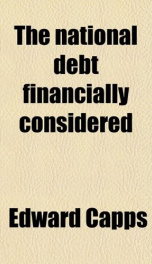the national debt financially considered

Purchase of this book includes free trial access to www.million-books.com where you can read more than a million books for free. This is an OCR edition with typos. Excerpt from book: the current rate of interest, by creating a stock Chap. in. bearing an interest of 5 per cent., which would then be called a 5 per cent, stock, and for every £100 of which the government would be able to obtain £100 in money. This, we say, would be the simple and obvious mode; and, by adopting it, no more stock or debt would be created than money received. Let us next suppose that, instead of doing this, the Government, either because it has been accustomed to do so, or because the wealthy people who lend money like it best, determines to borrow the £10,000,000 required, in a 3 per cent, stock, being a rate of interest 2 per cent, lower than the current rate prevailing at the time. Now, what is the result? Just this:the parties who lend the money, or, in other words, bargain for and purchase the stock, would naturally say, " We cannot give so utuch for a 3 per cent, stock as we can for a 5 per cent. one. For a 5 per cent, stock, we can give £100 for every £100 stock, but if it is to be only a 3 per cent, stock, we can only give £60 money for it. By adopting this mode, therefore, the Government must necessarily create more stock or debt than the money it receives for it; for it must create £ i 00 debt for every £60 money. In the case under consideration, the Government would not be able to obtain the £10,000,000 it wanted, without creating upwards of 16£ millions of debt; the full amount of which the country would be rendered liable to pay, should itChap. m. ever be in the position, or have the wish, to pay off the stock thus created. i78i. As an officially authenticated specimen of this mode Resolutions . " f of the of borrowing money, and certainly one of the most Commons. J' flagrant on record, we insert the resolutions of the House of Commons of March 8th, ...
Info about the book
Author:
Series:
Unknown
ASIN:
075464944X
Rating:
3.5/5 (4)Your rating:
0/5
Languge:
English
Users who have this book
Users who want this book
What readers are saying
What do you think? Write your own comment on this book!
write a commentGenre
if you like the national debt financially considered try:
Do you want to read a book that interests you? It’s EASY!
Create an account and send a request for reading to other users on the Webpage of the book!



